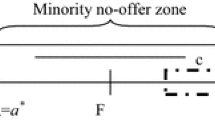Abstract
I calculate U.S. presidents’ power and power use concerning the ideological direction of U.S. Supreme Court decisions through their ability to appoint replacements to the Court, over the period 1946 through 2001. I test hypotheses concerning factors affecting appointment power and power use, and examine their effect on Senate confirmation votes. Of nine presidents, four have had the ability to affect the direction of more than 25 percent of Court decisions for sustained periods of time. Strongly ideological power use in appointment is found for four also. Senate confirmation votes have tended to be more favorable when the president has more appointment power.
Similar content being viewed by others
References
Abraham, H. J. (1985). Justices and Presidents: A Political History of Appointments to the Supreme Court. New York: Oxford University Press.
Baum, L. (1988). Measuring policy change in the U.S. Supreme Court. American Political Science Review, 82, 905–912.
Baum, L. (1997). The Puzzle of Judicial Behavior. Ann Arbor, MI: University of Michigan Press.
Brenner, S. (1995). Fluidity in voting on the United States Supreme Court: A bibliographic overview of the studies. Law Library Journal, 87, 380–386.
Brenner, S., & Krol, J. F. (1989). Strategies in Certiorari Voting on the United States Supreme Court. Journal of Politics, 51, 828–840.
Caldeira, G. A., Wright, J. R., & Zorn, C. J. W. (1999). Strategic voting and gatekeeping in the Supreme Court. Journal of Law, Economics and Organization, 15, 549–572.
Chapman, B. (1994). The Rational and the Reasonable: Social Choice Theory and Adjudication. University of Chicago Law Review, 61, 41–122.
Chapman, B. (1998). More Easily Done Than Said: Rules, Reasons and Rational Social Choice. Oxford Journal of Legal Studies, 293, 293–329.
Chapman, B. (2003). Rational Choice and Categorical Reason. University of Pennsylvania Law Review, 151, 1169–1210.
Cox, A. (1987). The Court and the Constitution. Boston: Houghton Mifflin.
Dahl, R. A. (1957). Decision-Making in a Democracy: The Supreme Court as a National Policy-Maker. Journal of Public Law, 6, 279–295.
Dahl, R. A. (1961). Who Governs? Democracy and Power in an American City. New Haven, CT: Yale University Press.
Drucker, P. F. (1995). Managing in a Time of Great Change. New York: Truman Talley.
Edelman, P. H., & Sherry, S. (2000). All or nothing: Explaining the Size of Supreme Court Majorities. North Carolina Law Review, 78, 1225–1249.
Epstein, L., Segal, J. A., Spaeth, H. J., & Walker, T. G. (2003). The Supreme Court Compendium: Data, Decisions, and Developments. Washington, DC: CQ Press.
Hopcroft, R. L. (1999). Maintaining the Balance of Power: Taxation and Democracy in England and France, 1340–1688. Sociological Perspectives, 42(1), 69–96.
Kermode, F. (2003). The Age of Shakespeare. New York: Modern Library.
Palmer, J. (1990). The Vinson Court Era. New York: AMS.
Perry, H. W. Jr. (1991). Deciding to Decide: Agenda Setting in the United States Supreme Court. Cambridge, MA: Harvard University Press.
Schubert, G. (1965). The Judicial Mind: The Attitudes and Ideologies of Supreme Court Justices, 1946–1963. Evanston, IL: Northwestern University Press.
Schwartz, B. (1983). Super Chief, Earl Warren and His Supreme Court. New York: New York University Press.
Segal, J. A., & Spaeth, H. J. (2002). The Supreme Court and the Attitudinal Model Revisited. Cambridge, UK: Cambridge University Press.
Segal, J. A., Timpone, R. J., & Howard, R. M. (2000). Buyer Beware? Presidential Influence Through Supreme Court Appointments. Political Research Quarterly 53, 557–573.
Starr, K. W. (2002). First Among Equals: The Supreme Court in American Life. New York: Warner Books.
Stearns, M. L. (2000). Constitutional Process: A Social Choice Analysis of Supreme Court Decision Making. Ann Arbor, MI: University of Michigan Press.
Tribe, L. H. (1985). God Save This Honorable Court: How the Choice of Supreme Court Justices Shapes Our History. New York: Random House.
Whitmeyer, J. M. (2000). Power through Appointment. Social Science Research, 29, 535–555.
Author information
Authors and Affiliations
Corresponding author
Rights and permissions
About this article
Cite this article
Whitmeyer, J.M. Presidential Power over Supreme Court Decisions. Public Choice 127, 97–121 (2006). https://doi.org/10.1007/s11127-006-7108-6
Accepted:
Issue Date:
DOI: https://doi.org/10.1007/s11127-006-7108-6




